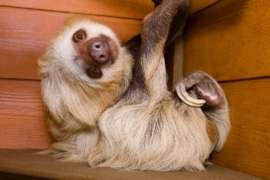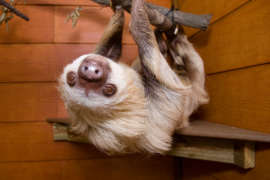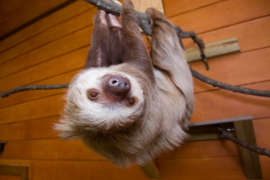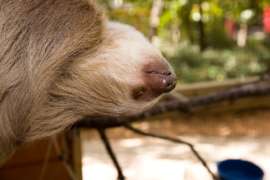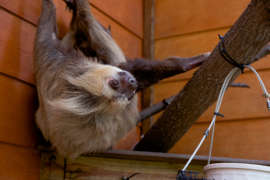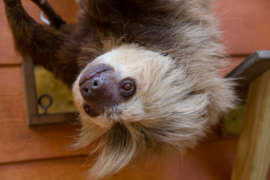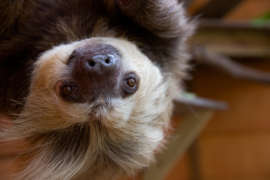Hoffmann’s Two-toed Sloth
Hoffmann’s Two-toed Sloth
Sloths are arboreal animals and are slow and deliberate rather than swift and agile. Specialized, enlarged claws enable them to hang upside down below the branches they traverse. Sloths derive their entire diet of leaves and some fruits in the trees, and they do almost everything upside down.
Choloepus hoffmanni
Herbivore
Mesoamerica, South America [VIEW MAP]
Forests, Rainforests
The sloths at Zoo Atlanta may be found in two habitats in KIDZone and Base Camp Discovery. The sloths at Base Camp Discovery may be seen year-round, while in the KIDZone habitat, they spend the cooler months in a warm indoor area. Sometimes it can take a bit of close looking to notice a sloth sleeping in an upper corner, or on a shelf, in their habitat —and don’t be surprised if they don’t move at all during your entire visit to the Zoo!
Photos and Videos
Sloths do most everything upside down. They eat, sleep, mate, and give birth in trees while hanging upside down. They only leave the trees to go to another tree or to defecate. Although clumsy and slow on the ground, their powerful, sharp claws present a deterrent to many predators. Predators include jaguars, large snakes and harpy eagles. Sloths are nocturnal, typically sleeping all day until after sunset—averaging about 15 hours asleep each day. Sloths are not very social; they usually keep their distance from each other without being territorial. Because the sloth spends most of its time upside down, its internal organs are rotated 135 degrees toward its back. The long claws are used to anchor to tree branches but also make formidable weapons if the animal is threatened. Their low rate of metabolism enables them to live on relatively little food, which consists entirely of leaves and fruits.
Hoffmann’s two-toed sloths have long gray or brown hair that is oriented in the opposite direction of most mammals; in this case, extending from their stomach toward the back. Their hair can become covered with blue-green algae during the rainy season, giving them a greenish appearance and helping them to blend in with their surroundings. Their body length ranges from 21 to 29 inches, and they weigh 9 to 20 pounds. The head has a flattened face with a naked and protruding snout; the ears are so small that they generally are hidden by the fur. Like so many features of a sloth’s anatomy, the teeth are unusual in that they are cylindrical, brown, and lack enamel. The hands and feet are highly specialized, with naked, heavily calloused soles and palms, with only two digits on the forelimbs and three on the hind limbs. Each digit bears a distinctive sickle-shaped claw. The claws clasp branches and are able to passively support a sleeping sloth.
Sloths may live around 20 years in the wild, and up to 40 in zoological settings. They mate generally once per year and, after a long gestation (up to 12 months), they produce a single offspring. The baby will cling tightly to its mother’s fur, and young sloths remain near their mothers for around a year.
The sloths at Zoo Atlanta may be found in two habitats in KIDZone and Base Camp Discovery. The sloths at Base Camp Discovery may be seen year-round, while in the KIDZone habitat, they spend the cooler months in a warm indoor area. Sometimes it can take a bit of close looking to notice a sloth sleeping in an upper corner, or on a shelf, in their habitat —and don’t be surprised if they don’t move at all during your entire visit to the Zoo!
Costa Rica in lower Central America, across Panama, northwestern Colombia and into Ecuador.
Lowland rainforest
All sloths are strict vegetarians, eating primarily tree leaves and some fruits. At Zoo Atlanta, we offer vegetables, fruits and a variety of non-poisonous tree leaves from different trees around the Zoo.

